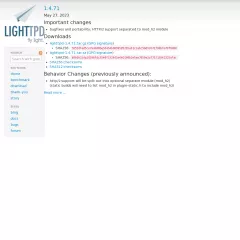lighttpd 
lighttpd is used by 0.07% of sites
Official Website
http://www.lighttpd.netCategory
Web Servers
lighttpd, also known as Lighty, is a lightweight and efficient open-source web server software. It is designed to be fast, secure, and flexible, making it a popular choice for serving static and dynamic content on websites. Lighttpd is known for its low memory footprint and efficient resource usage, making it suitable for systems with limited resources or high-traffic websites.
Here are some key features and characteristics of lighttpd:
High Performance: Lighttpd is designed for high-performance web serving. It uses an event-driven architecture that allows it to handle a large number of concurrent connections efficiently. Lighttpd can serve static files quickly and efficiently, making it suitable for scenarios where speed and responsiveness are crucial.
Lightweight and Low Resource Usage: Lighttpd is lightweight and consumes minimal system resources. It has a small memory footprint, making it suitable for low-end hardware or environments with limited resources. Lighttpd's efficient resource usage enables it to handle a large number of concurrent connections without excessive memory or CPU consumption.
Flexible Configuration: Lighttpd offers a flexible and easy-to-configure setup. Its configuration file allows you to customize various server settings, including virtual hosts, URL rewriting, access controls, and more. Lighttpd's configuration syntax is straightforward and well-documented, making it easy to set up and maintain.
FastCGI and Proxy Support: Lighttpd supports FastCGI, allowing you to connect to external applications or programming languages for dynamic content generation. It also has built-in proxy server capabilities, enabling you to act as a reverse proxy or load balancer for distributing requests across multiple backend servers.
TLS/SSL Support: Lighttpd supports Transport Layer Security (TLS) and Secure Sockets Layer (SSL) encryption for secure HTTPS connections. It provides options for configuring SSL certificates, enabling you to serve websites securely.
URL Rewriting and Redirects: Lighttpd supports URL rewriting and redirect rules, allowing you to define custom URL mappings or redirect patterns. This feature is useful for implementing SEO-friendly URLs, handling URL redirects, and managing complex URL structures.
FastCGI Caching: Lighttpd supports caching of FastCGI responses, which can significantly improve the performance of dynamic content generation. By caching the generated content, Lighttpd can serve subsequent requests for the same content without invoking the backend application, reducing response times and server load.
Lighttpd is well-suited for scenarios that require a lightweight, efficient, and flexible web server. It is commonly used in environments with limited resources, high traffic, or a need for fast and efficient content delivery.
Here are some key features and characteristics of lighttpd:
High Performance: Lighttpd is designed for high-performance web serving. It uses an event-driven architecture that allows it to handle a large number of concurrent connections efficiently. Lighttpd can serve static files quickly and efficiently, making it suitable for scenarios where speed and responsiveness are crucial.
Lightweight and Low Resource Usage: Lighttpd is lightweight and consumes minimal system resources. It has a small memory footprint, making it suitable for low-end hardware or environments with limited resources. Lighttpd's efficient resource usage enables it to handle a large number of concurrent connections without excessive memory or CPU consumption.
Flexible Configuration: Lighttpd offers a flexible and easy-to-configure setup. Its configuration file allows you to customize various server settings, including virtual hosts, URL rewriting, access controls, and more. Lighttpd's configuration syntax is straightforward and well-documented, making it easy to set up and maintain.
FastCGI and Proxy Support: Lighttpd supports FastCGI, allowing you to connect to external applications or programming languages for dynamic content generation. It also has built-in proxy server capabilities, enabling you to act as a reverse proxy or load balancer for distributing requests across multiple backend servers.
TLS/SSL Support: Lighttpd supports Transport Layer Security (TLS) and Secure Sockets Layer (SSL) encryption for secure HTTPS connections. It provides options for configuring SSL certificates, enabling you to serve websites securely.
URL Rewriting and Redirects: Lighttpd supports URL rewriting and redirect rules, allowing you to define custom URL mappings or redirect patterns. This feature is useful for implementing SEO-friendly URLs, handling URL redirects, and managing complex URL structures.
FastCGI Caching: Lighttpd supports caching of FastCGI responses, which can significantly improve the performance of dynamic content generation. By caching the generated content, Lighttpd can serve subsequent requests for the same content without invoking the backend application, reducing response times and server load.
Lighttpd is well-suited for scenarios that require a lightweight, efficient, and flexible web server. It is commonly used in environments with limited resources, high traffic, or a need for fast and efficient content delivery.